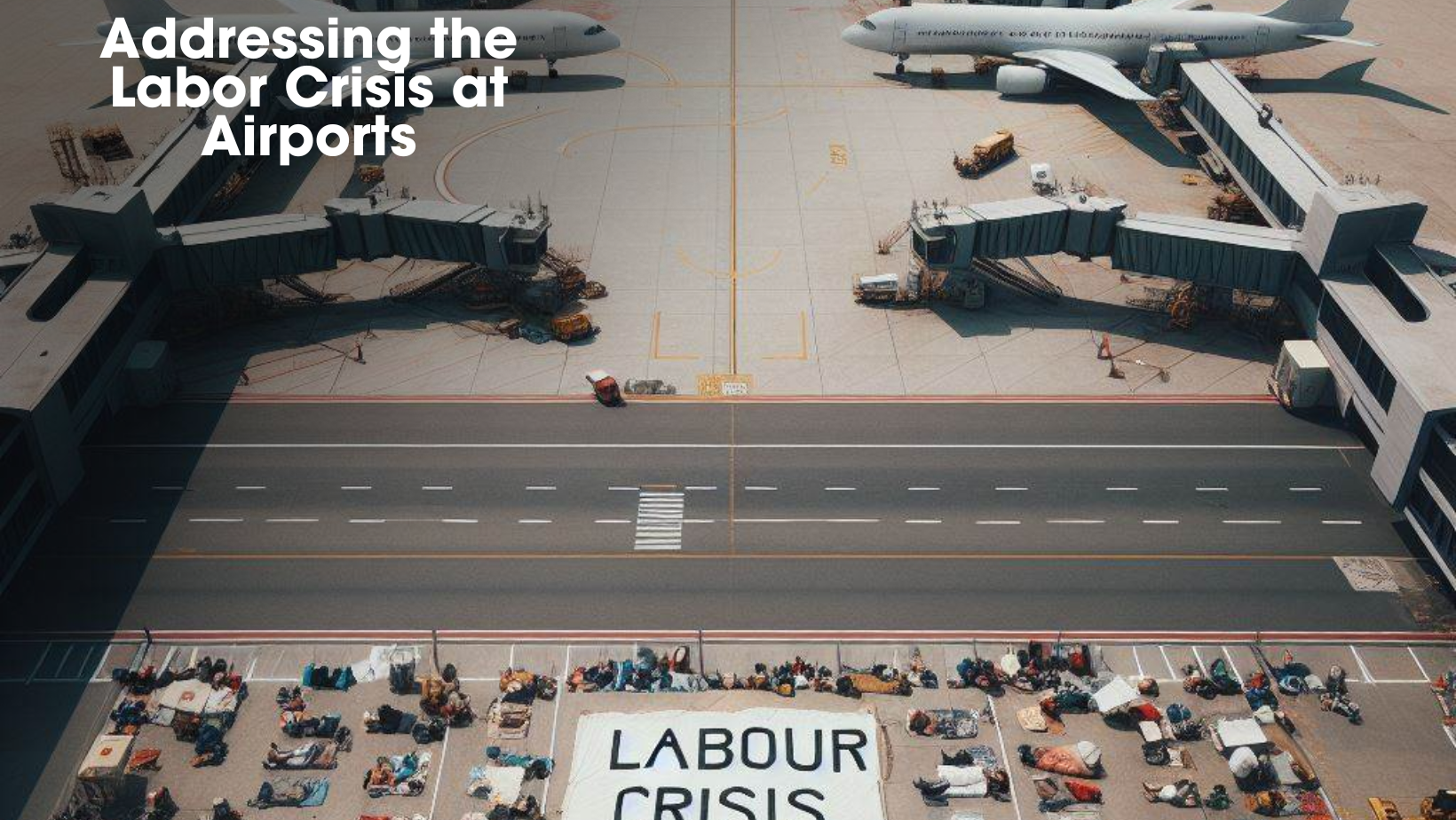Introduction
The labor crisis at airports is a common problem all over the world that has been affecting the aviation industry for a long time. The aviation industry has experienced remarkable growth in recent years. There has significant increase in passenger traffic, as well as cargo moving through airports. Airbus predicts that over the next 20 years, from 2019 to 2042, the need for air travel will increase by about 3.6% each year. (Airbus, 2023). But with this significant growth in the aviation industry, a complicated problem has come up: labor crises at airports. To make sure everything runs smoothly and passengers have a great and hassle-free experience, we need to have sufficient highly skilled, motivated, and helpful employees. (Christian J. G. Popp, 2016).
As aviation is a very sensitive industry due to its global connectivity disruption at a single airport not only affects one airport or one country but you can see its effect on other airports as well. Airports around the world have faced severe amount of labor crises that resulted in operation disruptions in major areas including security, GSE, etc which ultimately resulted in passenger inconvenience. At the 6th GHI Americans Conference1 the panel discussed the importance of skilled employees, and challenges in the ground handling industry.
Importance of addressing the labor Crisis
It’s important to realize that the labor crisis at airports has major consequences. This incident is a reminder of how important it is to have dedicated, well-trained employees to ensure the smooth, safe, and successful running of airports. Due to the rise in passenger traffic and the use of aviation services, these factors become even more crucial as the aviation industry continues to evolve and expand. The International Air Transport Association (IATA) 2020 research highlights the significance of a comprehensive plan of action to address the growing labor crisis. These strategies address hiring and retaining qualified workers, offering chances for professional development and training, and guaranteeing the well-being of employees.
Recognizing the complexity and urgency of labor challenges at airports, the objective of our study is to provide a comprehensive approach to labor crises. In the following sections, we will thoroughly examine the essential components of this proposed approach, considering which factors impact the labor market of aviation, passenger satisfaction, and the aviation industry as a whole. Our goal is to offer actionable recommendations to stakeholders by combining academic knowledge with practical insights. Ultimately, our primary goal is to ensure that airports consistently deliver exceptional experiences for both employees and passengers, meeting the expectations of the future.
Why is there a shortage of staff at airports?
Geoff Culbert, the chief executive officer of Sydney Airport said that half of the workforce at the airport lost their job during the COVID-19 pandemic. After the recovery from the pandemic, the flow of passengers increased drastically overloading the personnel working in the airports. This also leads the employees to quit their jobs as they feel they are treated unfairly while some others have left due to their pay cut.
Now, it is getting difficult for airports to recruit employees fast, having a shortage of workforce at the airports.
Challenges Faced and Solutions Needed
- Skilled Workforce Shortage: The scarcity of skilled workers in critical roles can disrupt airport operations and compromise safety. Solutions include targeted recruitment strategies, specialized training programs, and competitive incentives to attract and retain talent (Lim-U-Sanno, 2023).
- Working Conditions and Job Satisfaction: Addressing concerns related to working conditions, wages, and overall job satisfaction is crucial. Improving employee benefits, offering career advancement opportunities, and creating a supportive work environment can enhance staff morale (Baeriswyl et al., 2016).
- Cyclical Nature of the Aviation Industry: The industry’s vulnerability to economic downturns and global events necessitates adaptable workforce strategies. Developing contingency plans, cross-training employees, and implementing flexible staffing models can ensure stability during turbulent periods.
A shortage of staff in these key roles can result in interruptions to airport operations and raise safety issues, emphasizing the critical need for a well efficient and active workforce. This shortage can have a negative influence on the flow of operations, potentially compromising safety protocols and the overall efficiency of the passengers and the airport. Therefore, the presence of a reliable and expert workforce is of utmost importance to maintain smooth and secure airport operations.
How to address the labor crisis?
The usage of advanced and latest technologies will reduce the workload for the staff. The involvement of technology comes with many benefits like optimized workload coverage, and enhanced strategies that ultimately result into staff satisfaction. Utilizing advanced technologies can alleviate the workload on airport staff. Automation and artificial intelligence can optimize workload coverage, enhance strategic planning, and ultimately improve staff satisfaction. The integration of technology not only boosts efficiency but also necessitates continuous training and upskilling efforts for the existing workforce (Иванов & Webster, 2019).
Recommendations and Actionable Insights
Industry experts that include, including airport managers, airlines, and labor unions must engage with each other to come up with sustainable solutions. Taking support from the government for properly regulating job policies among the airports. Having proper training programs for enhancing the skills of the employees.
Promoting well-being, and implementing mental health support programs would alleviate the pressure on employees.
Addressing the labor crisis at airports demands a concerted effort from industry stakeholders and government entities. Collaborative engagements, comprehensive training programs, and prioritizing mental health and well-being are integral components of a holistic solution. By investing in these strategies, the aviation industry can ensure a skilled, motivated, and content workforce.
Conclusion
If this labor crisis problem at airports doesn’t get solved in time then the situation will get more worse. As long as this problem remains the reputation of the aviation industry will continue to suffer. The aviation industry’s reputation and operational efficiency are at stake due to the persistent labor crisis. Recruiting, training, integrating technology, and bettering working conditions are just a few of the various approaches needed to address this problem. The situation will worsen if this problem is not resolved quickly, which would affect not just airports but the aviation sector as a whole. The aviation industry can secure its future and guarantee a great experience for both workers and passengers by putting complete solutions into place.
References
Lim-u-sanno, K.,Wiroonrath, S., Wiroonratch, B., Jamjanta, J.(2023). Employees’ Opinions on Increasing Airport Non-Aeronautical Revenue Evidence in Thailand. International Journal of Economics and Finance Studies, 15(02), 347-364. doi:10.34109/ijefs.202315217
Baeriswyl S, Krause A and Schwaninger A (2016) Emotional Exhaustion and Job Satisfaction in Airport Security Officers – Work–Family Conflict as Mediator in the Job Demands–Resources Model. Front. Psychol. 7:663. doi: 10.3389/fpsyg.2016.00663
Christian Popp. (2016). Labor Relations at a Major Airline: Exploring Employee Performance Strategies. ScholarWorks | Walden University Research. https://scholarworks.waldenu.edu/cgi/viewcontent.cgi?article=3968&context=dissertations
Conceptual framework of the use of robots, artificial intelligence and service automation in travel, tourism, and hospitality companies. (2019, October 14). Discover Journals, Books & Case Studies | Emerald Insight. https://www.emerald.com/insight/content/doi/10.1108/978-1-78756-687-320191001/full/html
Global market forecast. (2021, June 16). Airbus. https://www.airbus.com/en/products-services/commercial-aircraft/market/global-market-forecast
https://www.iata.org/en/iata-repository/publications/economic-reports/understanding-the-pandemics-impact-on-the-aviation-value-chain/. (2022, December). IATA. https://www.iata.org/en/iata-repository/publications/economic-reports/understanding-the-pandemics-impact-on-the-aviation-value-chain/
View of employees’ opinions on increasing airport non-aeronautical revenue evidence in Thailand. (2023, July 24). AgBioForum – The Journal of Agrobiotechnology Management & Economics. https://agbioforum.org/sobiad.org/menuscript/index.php/ijefs/article/view/1542/396
Learn More about the 10 Busiest Airports in the world







Leave a Reply